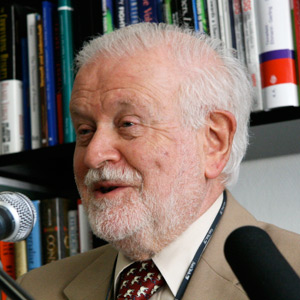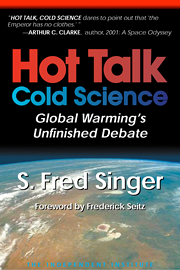There has been essentially no global warming since 1998. Some would choose 1997, others would more conservatively use 2002 as the proper starting date, based on satellite data. Of course, this is quite unexpected, since CO2—a leading GHG, which climate models presume to cause anthropogenic global warming (AGW)—has been increasing rapidly in the 21st century.
Even if we cannot readily find the cause for the “pause”—as it is sometimes called—we can be absolutely sure that it was not predicted by any of the dozens of the UN-IPCC’s General Circulation Models (GCMs). Therefore, logically, such non-validated GCMs cannot, and should not, be used to predict the future climate—or as a basis for policy decisions.
Here I would like to discuss some of the possible causes for the GW “hiatus.” Its existence is creating a scientific challenge for climate skeptics—and a real crisis for alarmists; it can no longer be ignored by any who consider themselves to be scientists—nor, indeed, by responsible politicians.
One possibility, of course, may be that the pause is simply a statistical fluctuation, like tossing a coin, with 15 to 18 heads in a row. Such an explanation cannot be dismissed out of hand, even though it has a very low probability—which becomes even smaller with each passing year of no GW. Obviously, climate alarmists like this possibility—although the number of such ‘true believers’ is shrinking. Most have started to look for a physical cause for the pause—an explanation of why current GCMs are failing to match observations.
Internal and External Causes
When we look at possible causes, we should first of all distinguish between internal and external ones that might offset the expected GW from CO2. Internal causes rely on negative feedbacks from either water vapor (WV) or clouds; they act to decrease the warming that should be attributed to increasing CO2. The problem with internal effects is they can never fully eliminate the primary cause—almost by definition. So even if they diminish the CO2 effect somewhat, there should still be a remaining warming trend, though small.
It is quite important to obtain empirical evidence for a negative feedback. In the case of water vapor, one would look to see if the cold upper troposphere (UT) was dry or moist. If moist, as assumed implicitly in current IPCC-GCMs, one gets a positive feedback—i.e., an amplification of the CO2-caused warming. On the other hand, if the upper troposphere is dry, then most emissions into space take place from WV in the warm boundary layer in the lower troposphere. This leaves less energy available to be emitted into space from the surface through the atmospheric ‘window,’ and therefore produces a cooler surface.
[NB: To avoid the vexing issue of the effects of the down-welling infrared radiation, it is easiest to think of long-term zero energy imbalance, as measured by satellites at the top of the atmosphere—after the underlying atmosphere adjusts. Imbalance = incoming less reflected solar radiant energy minus the heat energy from surface and atmosphere escaping to space.]
The physical model I have in mind for this negative WV feedback is based on a proposal of Prof. William Gray (Colorado State University), who pictured cumulus clouds carrying moisture into the UT, but occupying only a small area; the remaining (and much larger) area experiences descending air (“subsidence”)—hence drying. In principle, it should be possible to measure this difficult-to-explain effect fairly easily, using available satellite data.
Negative feedback from increased cloudiness is easier to describe but more difficult to measure. The idea is simply that a slight increase in sea-surface (SST) temperature (from the GH effect of a rising CO2) also increases evaporation (according to the well-known “Clausius-Clapeyron” relation), and that this increased atmospheric moisture can also increase cloudiness. The net effect is a greater (reflecting) albedo, less sunlight reaching the surface, and therefore a negative feedback that reduces the original warming from increasing CO2.
Unfortunately, establishing the reality of this cloud feedback requires a measurement of global cloudiness with an accuracy of a small fraction of a percent—a very difficult problem.
We now turn to external effects that might explain the existence of a global warming pause; the principal ones are volcanism and solar activity. The problem here is one of balancing; the amount of cooling by volcanism, for example, has to be just right to offset the warming from CO2 during the entire duration of the pause. It is difficult to picture why exactly this might be happening; the probabilities seem rather small. Still, the burden is on the proponents to demonstrate various kinds of evidence in support of such an explanation.
Similarly, atmospheric aerosols, generally human-caused, can increase albedo and cool the planet—especially if they also increase cloudiness by providing condensation nuclei for WV.
Hidden Warming?
Note that all the explanations mentioned so far act to reduce ‘climate forcing’—defined as the energy imbalance measured at the top of the atmosphere (TOA)
There is an important school of thought that does not rely on offsetting the forcing from increased CO2; instead it assumes that there really exists an imbalance at the TOA and that GW is taking place somewhere, but is not easily seen. Many assume that the “missing heat” is hiding in the deep ocean. It is difficult to see how such a mechanism can function without also raising surface temperatures; but an oscillation in ocean currents might produce such a result.
Still, if measurements could demonstrate a gradual increase in stored ocean heat, one would be forced to consider possible mechanisms. Its proponents might be asked, however, why the storage increase started just when it did; when will it end; and how will the energy eventually be released, and with what manifestations?There is yet another possibility worth considering: The missing energy might be used to melt ice rather than warm the ocean. Again, quantitative empirical evidence might support such a scenario. But how to explain the starting date of the pause—and how soon might it end?
Yet Another Explanation
It is generally accepted that the warming effect from CO2 increases roughly as the logarithm of CO2 concentration. The reason has to do with the broadness and shape of the CO2 absorption lines—as is well known among molecular spectroscopists. But even the log of CO2 would show a steady rise, albeit smaller than that of CO2 itself; so that this simple explanation does not work.
But CO2 is an interesting and complicated molecule. Its climate-forcing effect might actually decline to zero—albeit for only a number of years. The reason is that part of the CO2 absorption and emission takes place in the stratosphere, where the temperature gradient is positive, i.e. there is warming with increasing altitude, instead of cooling.
But until someone does the necessary work, by analyzing available satellite data, one should not put too much faith in this hypothesis.
So after all, the global warming pause still remains somewhat of a puzzle. The simplest description is that the climate sensitivity is close to zero—as demonstrated empirically. But why? How then to explain the reported surface warming from 1975 to 2000?
Conclusion
Regardless of any unsettled science details, it seems sure that current climate models cannot represent what is actually happening in the atmosphere—and therefore one should not rely on predictions from such unvalidated models that are based simply on increases of carbon dioxide. It should be obvious that this discussion has important policy consequences since so many politicians are wedded to the idea that CO2 needs to be controlled in order to avoid “dangerous changes of the global climate.”









